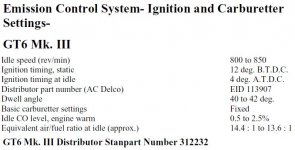OP
Will_Ringrose
Senior Member
Offline
Alright, I got a little distracted today, my friend called me and told me that there was a spitfire 1500 in the local pick and pull junkyard. So after taking some parts (door handles and tail lights)I got back to work.
I star by double cheeking the timing. I was at 8 Before.. sorry not after.
I replace the thermostat, and no difference. I then go to flush out the system. when running off straight water for a little bit to try and flush it out. the temp seems to be where I remember it being when running on just watter. I let it cool then drain, then add the 50/50. And as soon as the car warms up the anti-freeze is dis-colored and its right back up to the higher temp.
As a little test I turn on the heater fan, and the temp just drops after a few mins of running the heater fan.
What could this be? A blockage that wasn't dislodged? any idea on how to track something like this down?
What is the beat way to check the actual water temp? just let it warm up and stick the thermometer in the top of the radiator?
I star by double cheeking the timing. I was at 8 Before.. sorry not after.
I replace the thermostat, and no difference. I then go to flush out the system. when running off straight water for a little bit to try and flush it out. the temp seems to be where I remember it being when running on just watter. I let it cool then drain, then add the 50/50. And as soon as the car warms up the anti-freeze is dis-colored and its right back up to the higher temp.
As a little test I turn on the heater fan, and the temp just drops after a few mins of running the heater fan.
What could this be? A blockage that wasn't dislodged? any idea on how to track something like this down?
What is the beat way to check the actual water temp? just let it warm up and stick the thermometer in the top of the radiator?

 Hi Guest!
Hi Guest!

 smilie in place of the real @
smilie in place of the real @
 Pretty Please - add it to our Events forum(s) and add to the calendar! >>
Pretty Please - add it to our Events forum(s) and add to the calendar! >> 
